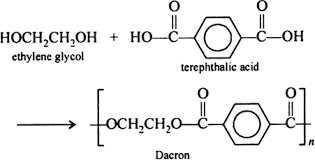
Which of the following is not correct regarding terylene?
A. Condensation Polymer
B. Synthetic fibre
C. Step growth polymer
D. Thermosetting plastic
Answer
218.7k+ views
Hint: The polymer is large molecules which are also called macromolecules. They are made from the addition or condensation of small monomers which may be monofunctional or bifunctional. Monofunctional monomers give us additional polymers while bifunctional monomers give us condensation polymers.
Complete Step by Step Solution:
Terylene is a form of condensation polymer arised from the condensation of ethylene glycol and terephthalic acid. The condensation has an outcome in the form of loss of water molecules. The condensation is written as:

Terylene is synthesised by the condensation of an alcohol i.e. ethylene glycol and an acid i.e. terephthalic acid. The reaction between alcohol and acid results in the development of an ester bond. As the monomers of ethylene glycol and terephthalic acid are associated by ester linkages and the ester is used for preparing clothes. So we call terylene a polyester fibre.
Terylene is a fibre , and not a thermosetting plastic because when we heat them they melt and do not show plastic property.
Terylene is made by the condensation of repeating units of bifunctional monomers to form long-chain polymers. In this whole process, the monomers merged to form dimmers then trimers then oligomers, and finally polymers. So terylene is a step-growth polymer.
Thus, Option (D) is correct.
Note: Terylene is not a chain growth polymer as they synthesised from the linkage of monomers with double and triple bonds. They are also called addition polymers. As it is synthesised by the condensation of two monomer units, so terylene is not a chain growth polymer.
Complete Step by Step Solution:
Terylene is a form of condensation polymer arised from the condensation of ethylene glycol and terephthalic acid. The condensation has an outcome in the form of loss of water molecules. The condensation is written as:

Terylene is synthesised by the condensation of an alcohol i.e. ethylene glycol and an acid i.e. terephthalic acid. The reaction between alcohol and acid results in the development of an ester bond. As the monomers of ethylene glycol and terephthalic acid are associated by ester linkages and the ester is used for preparing clothes. So we call terylene a polyester fibre.
Terylene is a fibre , and not a thermosetting plastic because when we heat them they melt and do not show plastic property.
Terylene is made by the condensation of repeating units of bifunctional monomers to form long-chain polymers. In this whole process, the monomers merged to form dimmers then trimers then oligomers, and finally polymers. So terylene is a step-growth polymer.
Thus, Option (D) is correct.
Note: Terylene is not a chain growth polymer as they synthesised from the linkage of monomers with double and triple bonds. They are also called addition polymers. As it is synthesised by the condensation of two monomer units, so terylene is not a chain growth polymer.
Recently Updated Pages
Is PPh3 a strong ligand class 12 chemistry JEE_Main

Full name of DDT is A 111trichloro22bispchlorophenyl class 12 chemistry JEE_Main

Sodium acetate on heating with soda lime produce A class 12 chemistry JEE_Main

Find the isoelectric point pI of Lysine A 556 B 974 class 12 chemistry JEE_Main

The order of basicity among the following compounds class 12 chemistry JEE_Main

The number of isomers in C4H10O are a7 b8 c6 d5 class 12 chemistry JEE_Main

Trending doubts
JEE Main 2026: Application Form Open, Exam Dates, Syllabus, Eligibility & Question Papers

Derivation of Equation of Trajectory Explained for Students

Hybridisation in Chemistry – Concept, Types & Applications

Understanding the Angle of Deviation in a Prism

Understanding Collisions: Types and Examples for Students

Understanding Atomic Structure for Beginners

Other Pages
NCERT Solutions For Class 12 Chemistry Chapter 1 Solutions - 2025-26

NCERT Solutions for Class 12 Chemistry Chapter Chapter 7 Alcohol Phenol and Ether

NCERT Solutions ForClass 12 Chemistry Chapter Chapter 8 Aldehydes Ketones And Carboxylic Acids

JEE Advanced Marks vs Ranks 2025: Understanding Category-wise Qualifying Marks and Previous Year Cut-offs

Haloalkanes and Haloarenes Class 12 Chemistry Chapter 6 CBSE Notes - 2025-26

Solutions Class 12 Chemistry Chapter 1 CBSE Notes - 2025-26




